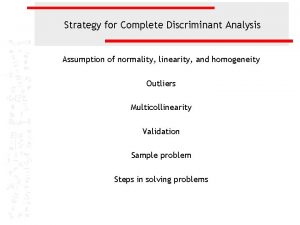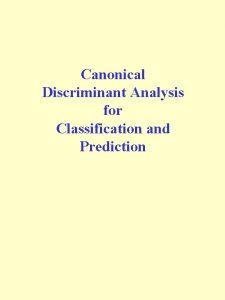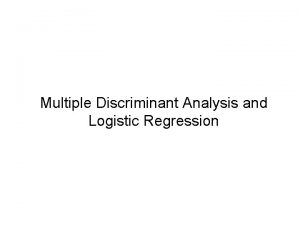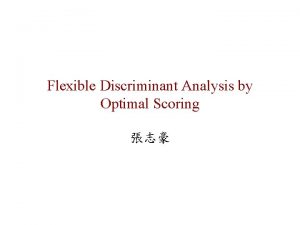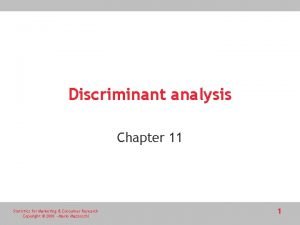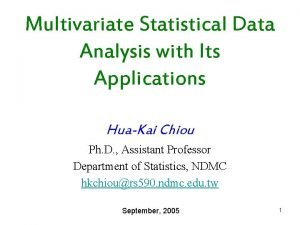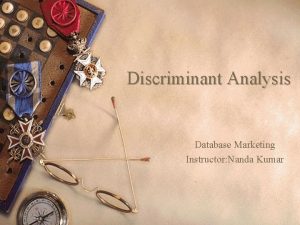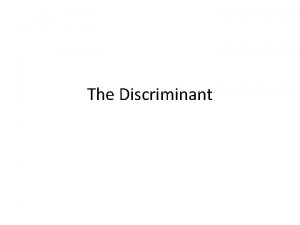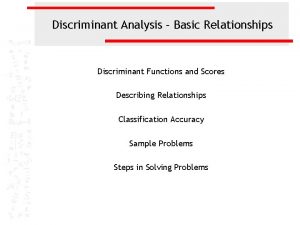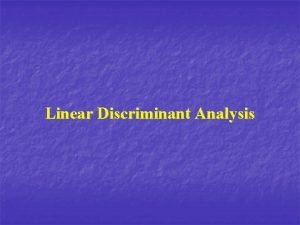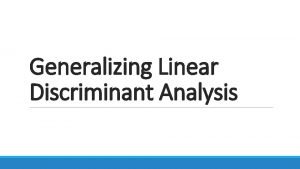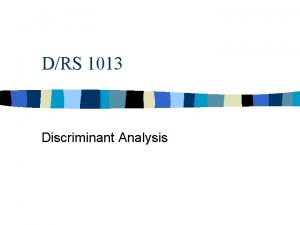CHAPTER18 DISCRIMINANT ANALYSIS q Development of discriminant functions






- Slides: 6

CHAPTER-18: DISCRIMINANT ANALYSIS q Development of discriminant functions, or linear combinations of the predictor or independent variables, which will best discriminate between the categories of the criterion or Dependent variable (groups). In example Amount spent on family vacation. q Examination of whether significant differences exist among the groups, in terms of the predictor or independent variables. q Determination of which predictor variables contribute to most of the intergroup differences. q Classification of cases to one of the groups based on the values of the predictor variables. MNH, MKT-416, DISCRI 1

This technique can be used to answer questions such as: q In terms of demographic characteristics, how do customers who exhibit store loyalty differ from those who do not? q Do heavy, medium, and light users of soft drinks differ in terms of their consumption of frozen foods? q What psychographic characteristics help differentiate between pricesensitive and non-price-sensitive buyers of groceries? q Do the various market segments differ in their media consumption habits? q In terms of lifestyles, what are the differences between heavy patrons of regional department store chains and patrons of national chains? q What are the distinguishing characteristics of consumers who respond to direct mail solicitations? MNH, MKT-416, DISCRI 2

Similarities and Differences between ANOVA, Regression and Discriminant Analysis Similarities ANOVA Regression Discriminant Analysis Number of dependent variables One One Number of independent variables Multiple Nature of dependent variables Metric Categorical (Likert) Nature of independent variables Categorical Metric Differences MNH, MKT-416, DISCRI 3

Steps associated with Discriminant Analysis Ø Formulate the problem q The next step is to divide the sample into two parts. q One part of the sample, called the estimation or analysis sample is used for estimation of the Discriminant function. q The other part called the holdout or validation sample for validating the Discriminant function. q For instance, if the total sample contained 50 percent loyal and 50 percent nonloyal consumers, then the analysis and validation samples would each contain 50 percent loyal and 50 percent nonloyal consumers. q On the other hand, if the sample contained 25 percent loyal and 75 percent nonloyal consumers, the analysis and validation samples would be selected to reflect the same distribution (25% versus 75%). MNH, MKT-416, DISCRI 4

q Data were obtained from 42 samples. q 30 included in the ANALYSIS SAMPLE and 12 included in VALIDATION SAMPLE. q Both ANALYSIS and VALIDATION SAMPLE were balanced in terms of VISIT. ( Yes 1, No 2) Ø q Estimate the Discriminant function coefficients Direct method where the predictors are included simultaneously Determine the significance of Discriminant function The null hypothesis is that in the population the means of all Discriminant functions in all group are equal. Ø Interpret the results q Standardized coefficient suggest that the chronological predictors in discriminating the groups between visited or not is based INCOME, HOUSEHOLD SIZE and IMPORTANCE ATTACHED TO FAMILY VACATION. q Group 1 visited has a positive value and 2, not visited has a negative value. MNH, MKT-416, DISCRI 5

Ø Page-579. table 18. 5, Wilk’s lambda ( U statistics) the lowest value suggest that the most important predictor in discriminating between the groups followed by others. Ø Page-579. table 18. 5, STRUCTURE MATRIX. the highest one suggest that the most important predictor in discriminating between the groups followed by others. Ø Page-579. table 18. 5, STANDARD CANONICAL DICRIMINANT FUNCTION COEFFICIENT (Find out the chronological) Ø Page-579. table 18. 5, CANONICAL DICRIMINANT FUNCTION EVALUATED GROUP MEANS ( GROUP CENTROIDS) (Find out the positive and negative) MNH, MKT-416, DISCRI 6
